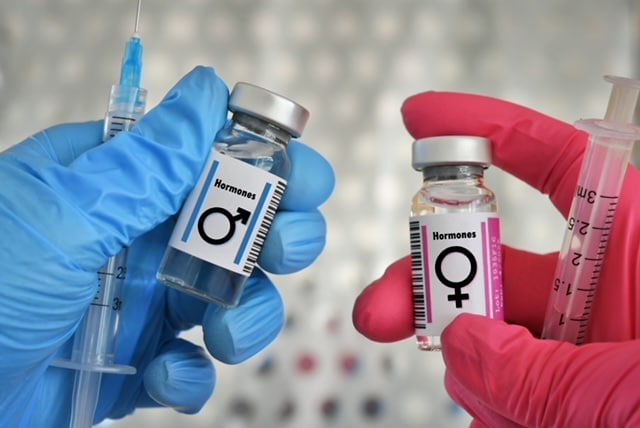In Part Two of Alexis Tarkalson’s fascinating interview with the trusted Dr. Quentin Van Meter, we go deeper into the heart of the transgender movement—exposing how ideology is rapidly dismantling the integrity of science and medicine, in favor of political agendas. Dr. Van Meter takes on the myth of “common” intersex conditions, debunking the false narrative that’s been pushed on society, and challenges the growing belief that gender identity is a simple matter of self-expression.
If you’ve been following this ideological conflict, this is an educated and professional perspective you need to hear— an in depth examination of the cultural forces shaping our understanding of gender.
Watching out for our children,
Wendy Wixom, President
United Families International
Unmasking Gender Ideology
How Activism Is Rewriting Medicine, Science, and Childhood
by Alexis Tarkalson
In part one of the conversation with Dr. Van Meter, pediatric endocrinologist and immediate past president for the American College of Pediatricians (ACPeds), we covered the various ways our youth are being lost to the social contagion of gender confusion. We touched on the end goal for this pathway, and the financial incentives to keep a child caught up in the world of gender ideology.
Part two will continue the conversation with Dr. Van Meter: hitting on the ideological sabotage of the medical field by trans activists, the medical boards responsibilities versus legislative intrusion, and how this impacts the scientific community.
The purpose behind my interview with Dr. Van Meter was to analyze the gender ideology phenomenon through the lens of a professional that has departed from the mainstream-approved path for treating minors dealing with gender dysphoria. Our conversation inevitably was one that was honest, explorative, evidence driven, and has real-world implications for medicine, research, policy, and parenting. It’s vital that families facing these issues read this article surmising our conversation, as well as the full interview here.
Entering the Medical Field with Conviction
With the integrity of much of the medical field in question after a swirl of controversial decisions regarding abortion and gender affirming care, many prospective medical students who pledge allegiance to the science, before the political agenda of the few, are now leery of entering the field.
I asked, “What advice would you give to [those] who want to enter the medical or psychiatric field but don’t align with the gender ideology being pushed right now?”
Dr. Van Meter had a great perspective. “There’s a principle here—like anything you hold as a personal conviction, whether it’s part of your moral compass, your religious faith, or something else that guides your life. You don’t abandon those convictions just because you’re entering a professional field. That said, you don’t necessarily have to wear them on your sleeve either… stand strong, be wise, and make your voice heard in the right places. Find like-minded colleagues. Build a supportive network. And when your group is strong enough not to be crushed like a bug, that’s the time to engage in dialogue.”
In sum, use prudence when deciding to declare your stance, but always stick to your principles.
He shared the willingness of the ACPeds to help as well as pro bono lawyers should you get in a sticky situation regarding your beliefs and the power of those over you.
Dr. Allen Josephson found himself caught in such a situation when he asserted during a panel discussion in 2017 that children are not capable of making life-altering decisions like sex change surgeries. Afterwards, the university Dr. Josephson had worked with for fifteen years, helping to make it more distinguished and nationally recognized, began targeting him and eventually refused to renew his contract.
After forty years in academia, he was cut from it, because he got caught in the crosshairs of gender activism. Alliance Defending Freedom took on his case and six years later won Dr. Josephson a settlement of $1.6 million dollars.
Dr. Van Meter summarized the case succinctly: “That case should serve as a warning to institutions: you cannot impose ideology at the expense of someone’s deeply held beliefs.”
The Scientific Method Under Siege
During the interview, I explained to Dr. Van Meter that I had taken a research methods course, and during that class we were required to complete a short APA tutorial on proper formatting. Part of that tutorial included a section on bias-free language. It stated that when referring to individuals, you should use the pronouns they personally use—for example, using she for someone who uses she/her, he for someone who uses he/him, and they for individuals who prefer they/them.
I asked how this shift might affect scientific research moving forward? If we’re conducting gender-related studies but can’t report participants’ biological sex accurately—or are required to use self-declared gender identities instead—how will that impact the integrity of the data and the validity of future research?
I went on to explain that The Foundation for Gender Specific Medicine (FGSM) was founded by Dr. Marianne Legato. She was inspired because, “My life changed one day when a talented medical journalist, Carol Colman, walked into my laboratory and said her mother had died of coronary artery disease—and that she believed it had been an unnecessary death because her mother’s treatment was based on a male model. She believed a woman’s experience of coronary artery disease might be different from that of a man.”
Dr. Legato founded FGSM in 1998 because of the default setting in the medical community to base medical care off of the experiences of men. With their research, they have found, “Sex does matter. It matters in ways that we did not expect. Undoubtedly, it also matters in ways that we have not begun to imagine. Men and women experience many of the same diseases differently. Gender-specific science produces lifesaving insights into human physiology and improves healthcare for all.”
I asked “What happens when people like Dr. Marianne Legato are dismissed as hateful bigots and incapable of accurate science because they acknowledge that there is such a thing as gender medicine?’
Dr. Van Meter answered my question with:
“Now, not every drug is affected by sex-based differences, but many are. And that’s more than enough justification to classify individuals by biological sex in epidemiological studies. That’s just how the human species functions. If you blur those lines—even for a small percentage of the population, say 3%—you can significantly skew your data. Whether we like it or not, biological sex is binary, and it has measurable consequences. Personal identity doesn’t change cellular biology.
These studies get picked up by major media outlets—Good Morning America, for example—and presented as groundbreaking evidence that transitioning saves lives, that it’s the only compassionate and scientific standard of care. But the studies themselves are often based on convenience samples, poor methodology, and ideological agendas. That’s not science—it’s propaganda dressed in a lab coat. And it absolutely shouldn’t pass the editorial standards of any serious journal.”
Scientific data is being manipulated and distorted. I fear soon we will no longer be able to trust research, as we will not be able to determine the makeup of the population being studied. Dr. Van Meter said, “In many of these studies, researchers won’t even clarify biological sex unless they absolutely have to… Most of the time, it’s left ambiguous—and honestly, it’s shady.”
Public Policy, Medical Boards, and Legislative Gaps
What role should the government play when medical boards fail?
Dr. Van Meter answered this question, “So yes, in a perfect world, physicians would govern themselves through professional boards with integrity and independence. But when those boards are ineffective or captured by ideology, the state is sometimes forced to intervene. It’s not ideal, but it may be necessary to restore medical standards and protect patients.”
He gave the example of the states of Wyoming and Texas. Both had State Medical Boards that were declining to address the harms of gender affirming care being utilized for children. Eventually, the state legislature had to step in and take a stand for vulnerable populations.
Gender Identity in the Family: Coincidence or Conditioning?
The world where Hollywood superstars operate is entirely different from any reality to which a regular person is accustomed. A-lister celebrities thrive in an environment where physical appearances are your ticket to success, reputations are as fragile as a carton of eggs, and who you know is more important than what you know. Now added to the list of importance is knowing someone personally that identifies with the LGBT community in some way.
Here is a list of celebrities that have trans identifying children and/or family members:
- Jamie Lee Curtis has a trans daughter named “Ruby”
- Naomi Watts has a trans daughter named “Kai”
- Rosie O’Donnell (who is apart of the LGBT community herself) has a child who identifies as “non-binary”
- Sigourney Weaver has a child who identifies as “non-binary”
- Jennifer Lopez introduced her child with “they/them” pronouns in 2022 and advocates for her transgender “nibling” (gender neutral way of referring to a neice/nephew)
- Robert Di Niro’s son came out as a trans woman this year
- Cynthia Nixon (who identifies with the LGBT community) has a trans son
- Marcia Gay Harden is the mother to three queer and trans kids
- Charlize Theron’s adopted child has been identifying as trans since he was three years old (He is currently twelve years old)
This list can continue, as there are more and more celebrities introducing their children to the world as being transgender. The thing is, it’s highly unlikely. The percentage of people identifying in the U.S. is 0.6%, which is over 1.6 million people. For teenagers, the percentage is higher, at 1.4%, which makes sense as teenagers are more prone to follow what the mainstream media dictates as being popular.
To have so many transidentifying children within such a small subset of the population (Hollywood) is just statistically unlikely. If just eight children identify as transgender in a group of forty people, that is already thirteen times over the national average. It’s no longer just Hollywood jumping on this train too, as quite a few instagram influencers are documenting the sex-changes of their children, sometimes they have more than one. This indicates there is an environmental factor, social contagion, parental affirmation dynamic, and/or mental health or trauma playing a significant role in the lives of these children.
Dr. Van Meter had this to say when I relayed my concerns: “There is no biological basis for any of this. Twin studies show there isn’t 100% concordance, and there are no known genetic markers in the human genome that indicate gender identity or sexual orientation. So when you see multiple identities like ‘non-binary,’ ‘trans,’ ‘lesbian,’ and ‘gay’ all represented within one household, it raises red flags…It’s not genetics—it’s psychological manipulation. And frankly, it’s a form of environmental abuse.”
The Myth of “Common” Intersex Conditions
Finally, Dr. Van Meter and I arrived at the topic of intersex individuals.
I asked, “I was reviewing the gender resource book provided by the Trevor Project, and I came across many statements that shocked me and raised serious concerns—what I believe are blatant falsehoods. For example, they repeatedly claim that being intersex is very common and that there are no differences between male and female brains. My question is: do you think they are intentionally being deceitful, or are they so deeply entrenched in their own agenda that they’re simply misinterpreting the information?”
Dr. Van Meter then explained the various forms of “intersex” (although he feels intersex is a misleading term and prefers to use “disorders of sexual development”, DSD).
There is the controversial and vastly misunderstood circumstance called Complete Androgen Insensitivity Syndrome (CAIS). This is when an individual is born with male chromosomes (XY) but does not respond to male hormones (androgens). This results in the individual developing externally as a female. They literally have no receptors for androgens anywhere in their body, and therefore in every way except for their DNA, they are female. “They are the only group living in bodies that genetically should be male but are entirely female in form and function… They are raised as girls, and their gender identity is female—without confusion… It represents about 0.003% of the population,” says Dr. Van Meter
Other individuals with DSD can be boys with underdeveloped genitalia. He explains: “These individuals may have an enlarged clitoris that resembles a small penis, but it never fully forms into one. They do not have internal female reproductive structures like a uterus, ovaries, or fallopian tubes. They are simply under-virilized males, though less so than the CAIS cases.
Most of these individuals are raised as males because their genitalia can often be enhanced with hormone treatment. If given testosterone, their genitalia will virilize. In contrast, giving testosterone to girls with CAIS has no effect because their bodies cannot respond to the hormone.”
The LGBT community tries to throw girls with Turner Syndrome or boys with Klinefelter Syndrome into the “intersex” mix. But the truth is, they are just people whose reproductive organs have not been able to form all of the way.
I then asked, “So would you say there’s never a case where it’s up in the air of what they are?”
He responded, “The ethics committee, along with urologists and endocrinologists, work together—while keeping parents involved and educated—to determine the best path for the child’s physical reproductive and sexual function. In the vast majority of cases, the decision aligns with the child’s chromosomal sex.”
(For well-researched and easy-to-understand explanations of the various Disorders of Sexual Development (DSD), visit the Paradox Institute.)
Conclusion
Gender affirming care is not going away on its own. It cannot be ignored, it will require a vigorous and persistent resistance on our part. The public at large needs to be made aware of the dangers and the permanent effects this movement can have on our youth.
To effectively reach those sitting on the fence regarding this matter, we must come from a place of understanding and compassion, showing that we care for these individuals. But while we care for them, we also see the imperative need to maintain honesty in medical practices, and therefore must make them aware that the path of gender-affirming care is not one that will end happily. This recent historical anomaly, where we align body to mind rather than mind to body, is conflating ideology with science. And there is real and inherent danger in doing so.
This interview with Dr. Van Meter provides clarity and should encourage us all to continue defending truth, protecting children, and hopefully trust and faith in the medical institutions will be restored.


 Alexis Tarkalson graduated from Brigham Young University-Idaho with her degree in Political Science and an emphasis in American Government. She loves spending time with her husband and little boy, reading, hiking mountains, and learning new hobbies. The family unit is immensely important to her, as is protecting the associated rights, which is why she volunteers her time towards United Families International.
Alexis Tarkalson graduated from Brigham Young University-Idaho with her degree in Political Science and an emphasis in American Government. She loves spending time with her husband and little boy, reading, hiking mountains, and learning new hobbies. The family unit is immensely important to her, as is protecting the associated rights, which is why she volunteers her time towards United Families International.